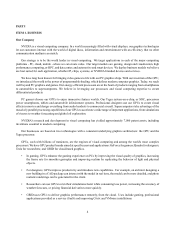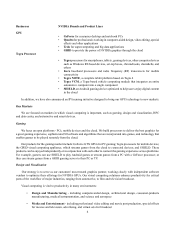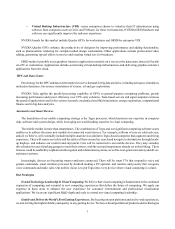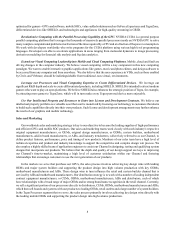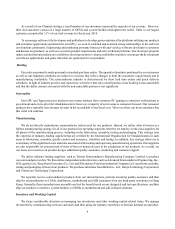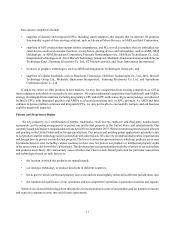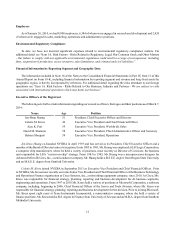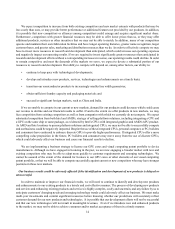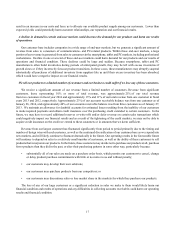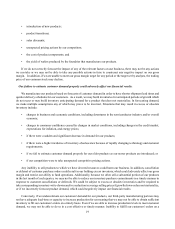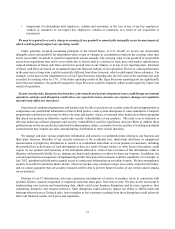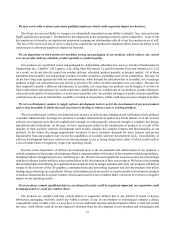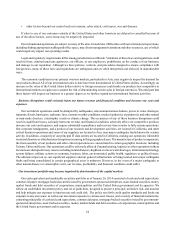NVIDIA 2013 Annual Report Download - page 158
Download and view the complete annual report
Please find page 158 of the 2013 NVIDIA annual report below. You can navigate through the pages in the report by either clicking on the pages listed below, or by using the keyword search tool below to find specific information within the annual report.14
We expect competition to increase from both existing competitors and new market entrants with products that may be
less costly than ours, or may provide better performance or additional features not provided by our products. In addition,
it is possible that new competitors or alliances among competitors could emerge and acquire significant market share.
Furthermore, competitors with greater financial resources may be able to offer lower prices than us, or they may offer
additional products, services or other incentives that we may not be able to match. In addition, many of our competitors
operate and maintain their own fabrication facilities and have longer operating histories, greater name recognition, larger
customer bases, and greater sales, marketing and distribution resources than we do. In order to effectively compete we may
have to invest more resources in research and development than anticipated, which could increase our operating expenses
and negatively impact our operating results. If we are required to invest significantly greater resources than anticipated in
research and development efforts without a corresponding increase in revenue, our operating results could decline. In order
to remain competitive and meet the demands of the markets we serve, we expect to devote a substantial portion of our
resources to research and development. Our ability to compete will depend on, among other factors, our ability to:
• continue to keep pace with technological developments;
• develop and introduce new products, services, technologies and enhancements on a timely basis;
• transition our semiconductor products to increasingly smaller line width geometries;
• obtain sufficient foundry capacity and packaging materials; and
• succeed in significant foreign markets, such as China and India.
If we are unable to compete in our current or new markets, demand for our products could decrease which could cause
our revenue to decline and our financial results to suffer. If and to the extent we offer products in new markets, we may
face competition from existing competitors as well as from companies with which we currently do not compete. We expect
substantial competition from both Intel and AMD's, strategy of selling platform solutions, including integrating a CPU and
a GPU on the same chip or same package, as evidenced by Intel's CPUs with integrated graphics and AMD's APU product.
As AMD and Intel continue to pursue platform solutions and integrated CPUs, we may not be able to successfully compete
and our business could be negatively impacted. Despite the use of these integrated CPUs, personal computer, or PC, builders
and consumers have continued to embrace discrete GPUs to provide higher performance. If integrated CPUs offer a more
compelling value proposition in the future, PC builders and consumers may move away from the use of discrete GPUs,
which could adversely affect our business and cause our financial results to decline.
We are implementing a business strategy to license our GPU cores and visual computing patent portfolio to device
manufacturers. Although we have engaged in licensing in the past, we are now engaging a broader market with new and
existing competitors who may be able to adapt more quickly to customer requirements and emerging technologies. We
cannot be assured of the extent of the demand for licenses to our GPU cores or other elements of our visual computing
patent portfolio, or that we will be able to compete successfully against current or new competitors who may have stronger
positions in these new markets.
Our business results could be adversely affected if the identification and development of new products is delayed or
unsuccessful.
In order to maintain or improve our financial results, we will need to continue to identify and develop new products
and enhancements to our existing products in a timely and cost-effective manner. The process of developing new products
and services and enhancing existing products and services is highly complex, costly and uncertain, and any failure by us to
anticipate customers' changing needs and emerging technology trends could adversely affect our business. We must make
multi-year investments and commit significant resources before knowing whether our predictions will accurately reflect
customer demand for our new products and technologies. It is possible that our development efforts will not be successful
and that our new technologies will not result in meaningful revenues. Even if we introduce new and enhanced products
to the market, we may not be able to achieve consumer and/or market acceptance of them in a timely manner.


